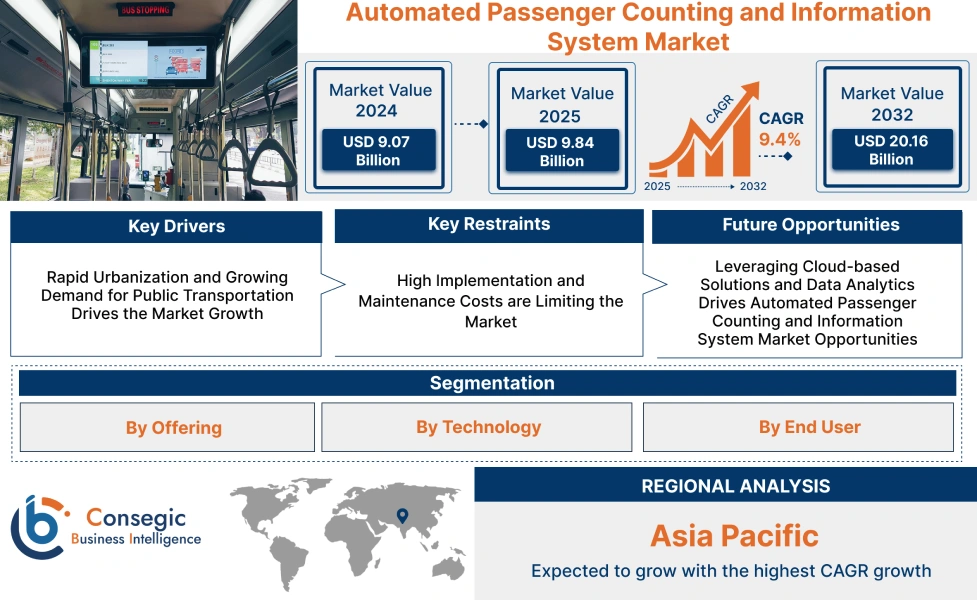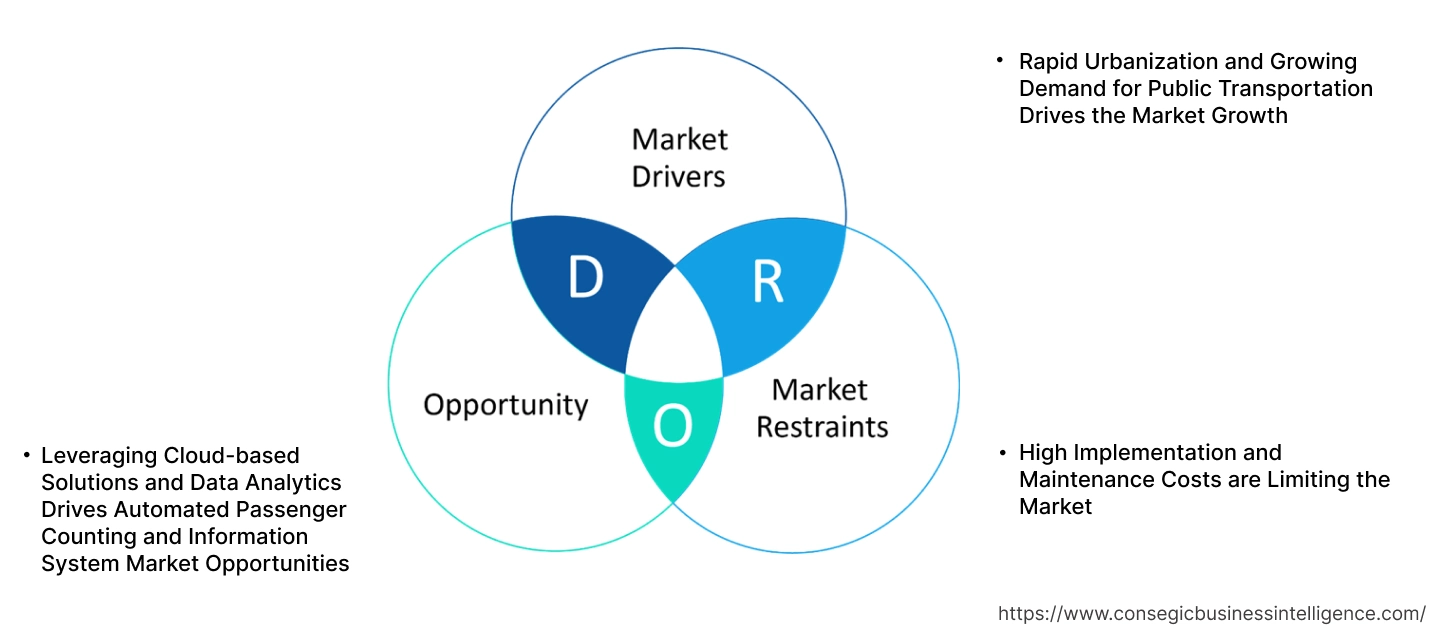Automated Passenger Counting and Information System Market Size:
Automated Passenger Counting and Information System Market is estimated to reach over USD 20.16 Billion by 2032 from a value of USD 9.07 Billion in 2024 and is projected to grow by USD 9.84 Billion in 2025, growing at a CAGR of 9.4% from 2025 to 2032.
Automated Passenger Counting and Information System Market Scope & Overview:
An automated passenger counting and information system is a comprehensive solution designed to enhance efficiency and user experience of public transportation. It accurately counts passengers boarding and alighting vehicles using various sensor technologies, while simultaneously providing real-time travel information to commuters through diverse channels. The benefits of the solution include enhanced operational efficiency, improved passenger experience and increased revenue. Further, key trends driving the market include increasing integration of AI and IoT for enhanced real-time data analytics, growing demand for personalized passenger information, and the continuous focus on optimizing operational efficiency and safety.
Impact of AI on Automated Passenger Counting and Information System Market
Artificial Intelligence has a huge impact on the automated passenger counting and information system market. AI is transforming the capabilities and unlocking new value in transportation industry. AI based system significantly enhances the accuracy of passenger counting, especially in complex scenarios, by differentiating between people, luggage, and other objects. Further, AI enables predictive insights, allowing transit operators to forecast passenger loads, anticipate bottlenecks, and dynamically adjust services in real-time. In case of PIS, AI drives hyper-personalization, delivering relevant and timely information to passengers based on their specific journey, preferences, and real-time conditions. This leads to improved operational efficiency, better resource allocation, and a seamless, user-centric travel experience across all modes of public transportation.
Key Drivers:
Rapid Urbanization and Growing Demand for Public Transportation Drives the Market Growth
Increasing urbanization, especially in emerging economies, is leading to an exponential increase in daily commutes and overall travel demand. This surge places immense pressure on existing public transportation infrastructure, necessitating more efficient and reliable solutions. Further, automated passenger counting and information system addresses the challenges posed by high passenger volumes. APC provides crucial real-time data on ridership, enabling transit authorities to optimize routes and allocate resources effectively, thereby reducing congestion and operational costs. Similarly, PIS enhances commuter experience by delivering timely and accurate information about schedules, delays, and vehicle capacity, fostering greater public reliance on mass transit.
- For instance, S. Federal Transit Administration (FTA) has allocated approximately USD 1.5 billion to fund 117 public transportation projects across 47 states. These investments are set to drive the market.
Thus, continuous expansion and modernization of public transportation networks, driven by government initiatives is driving the automated passenger counting and information system market size.
Key Restraints:
High Implementation and Maintenance Costs are Limiting the Market
The initial investment for deploying advanced automated passenger counting and passenger information system can be high for many public transportation agencies, especially smaller ones or those operating in developing regions with constrained budgets. This substantial upfront capital expenditure covers not only the sophisticated hardware, such as stereoscopic cameras and digital displays, but also the specialized software, system integration, and staff training. Further, beyond implementation, the ongoing maintenance, regular calibration of sensors, software updates, and potential repairs contribute significantly to the total cost of ownership. Thus, sustained operational expenses pose a considerable financial burden, limiting the widespread adoption of technologies.
Future Opportunities :
Leveraging Cloud-based Solutions and Data Analytics Drives Automated Passenger Counting and Information System Market Opportunities
Leveraging cloud-based solutions and advanced data analytics presents a significant opportunity for the automated passenger counting and information system market. Cloud platforms offer scalable and flexible infrastructure, enabling transit operators to store vast amounts of real-time passenger data without extensive on-premise hardware investments. This accessibility facilitates sophisticated data analytics, transforming raw figures into actionable insights about passenger flow, peak demand times, and service utilization. Further, operators can optimize routes, adjust schedules dynamically, and predict maintenance needs, leading to enhanced operational efficiency and greater passenger experience.
- For instance, in March 2023, Eurotech launched its new ReliaCOR portfolio of secure, IEC 62443-certified edge AI solutions. Aimed at the industrial, energy, and road vehicles markets, these edge servers offer scalable AI capabilities designed to combat growing cyber threats.
Thus, adoption of cloud-based solutions and data analytics driven by advantages such as scalability and flexibility drives automated passenger counting and information system market opportunities.
Automated Passenger Counting and Information System Market Segmental Analysis :
By Offering:
Based on the offering, the market is segmented into Automated Passenger Counting (APC) Systems and Passenger Information Systems (PIS).
Trends in the Offering:
- APC systems are increasingly leveraging AI and ML to extract richer insights which in turn drives the automated passenger counting and information system market trends.
- Increasing integration of APC system with ticketing and fare collection systems drives automated passenger counting and information system market size.
Passenger Information Systems (PIS) accounted for the largest revenue share in the year 2024 and is anticipated to register the fastest CAGR during the forecast period.
- PIS is moving beyond generic announcements to deliver highly personalized and contextual information including real-time alerts, driving the automated passenger counting and information system market share.
- Further, there is an increasing focus on providing integrated information across different transport modes within a single, which in turn drives the market.
- Furthermore, growing incorporation of AI and IoT for predictive and proactive information drives the automated passenger counting and information system market trends.
- For instance, according to International Air Transport Association (IATA), global air passenger traffic saw a substantial 36.9% increase in 2023 compared to the previous year. This is expected to drive the market growth in near future.
- Thus, as per analysis, growing personalization, multimodal integration, and advanced technology integration drives the automated passenger counting and information system market growth.
By Technology:
Based on the technology, the market is segmented into stereoscopic vision, infrared, Time-of-Flight (ToF), and IP Cameras.
Trends in the Technology:
- ToF technology is known for its resilience to varying light which in turn drives the automated passenger counting and information system market demand.
- Advanced video analytics with deep learning for counting and behavior analysis are driving the automated passenger counting and information system market share.
Infrared accounted for the largest revenue share in the year 2024.
- A significant trend for IR is its integration with other sensor types, particularly simple 2D cameras.
- Further, development of sophisticated algorithms that can filter out false counts caused by objects, shadows, or rapid environmental changes, drives the automated passenger counting and information system industry.
- Furthermore, emphasis on low power consumption and long-term reliability drives the market growth.
- Thus, as per automated passenger counting and information system market analysis, aforementioned factors are driving the market growth.
Stereoscopic vision is anticipated to register the fastest CAGR during the forecast period.
- There is an increasing use of AI and deep learning algorithms to segment passengers from the background and other objects which in turn drives the automated passenger counting and information system market demand.
- Further, manufacturers are focusing on improving the performance of stereoscopic vision systems in varied and challenging conditions which in turn propels the automated passenger counting and information system market expansion.
- Therefore, based on analysis, enhanced object recognition, and increased robustness are expected to boost the market during the forecast period.
By End User:
Based on the end user, the market is segmented into railways, roadways, airways, and waterways.
Trends in the End User:
- Growing need for real-time bus occupancy data to passengers via mobile apps and smart bus stop displays drives the automated passenger counting and information system market expansion.
- In airports, the technology is crucial for managing passenger flow through various touchpoints, including security checkpoints, check-in counters, immigration, and boarding gates.
Railways accounted for the largest revenue share of 35.42% in the year 2024 and is anticipated to register the fastest CAGR during the forecast period.
- Increasing adoption of the technology for connecting passenger data with signaling systems, train control, station management, and predictive maintenance platforms.
- Further, increasing urbanization and higher passenger volumes results in rising investment in sophisticated analytics tools powered by AI and machine learning which in turn drives the automated passenger counting and information system market growth.
- Furthermore, railways are moving towards highly personalized PIS, delivered through mobile apps and intelligent displays which in turn drive the market.
- Thus, as per automated passenger counting and information system market analysis, need for smart railway infrastructure, advanced passenger flow analytics, and personalized passenger information are driving the market.
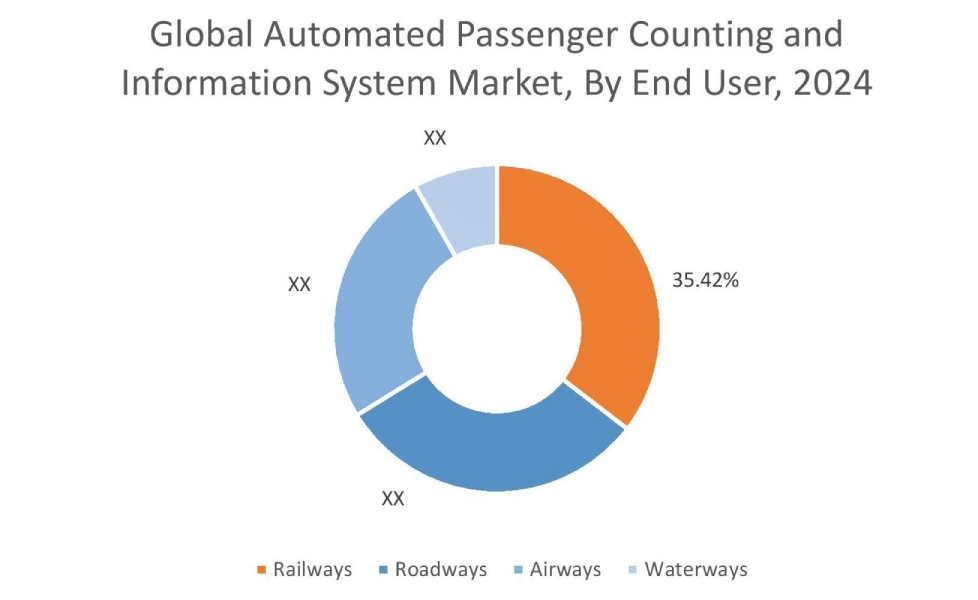
Regional Analysis:
The regions covered are North America, Europe, Asia Pacific, Middle East and Africa, and Latin America.
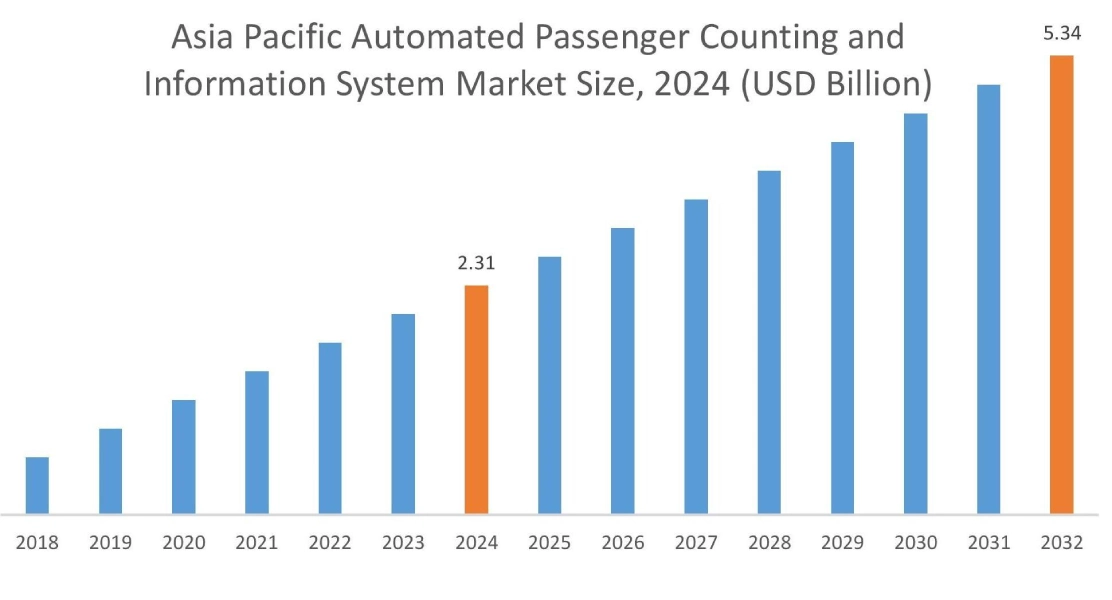
Asia Pacific region was valued at USD 2.31 Billion in 2024. Moreover, it is projected to grow by USD 2.51 Billion in 2025 and reach over USD 5.34 Billion by 2032. Out of this, China accounted for the maximum revenue share of 35.08%. The market for automated passenger counting and information system is mainly driven by rapid urbanization and expanding public transportation networks, particularly in countries like China, India, and Japan.
- For instance, according to IATA, in 2023 Asia-Pacific airlines demonstrated remarkable recovery in 2023, with international traffic surging by 126.1% compared to 2022, marking the highest growth rate globally. This significant increase is driving the need for automated software for crowd management.
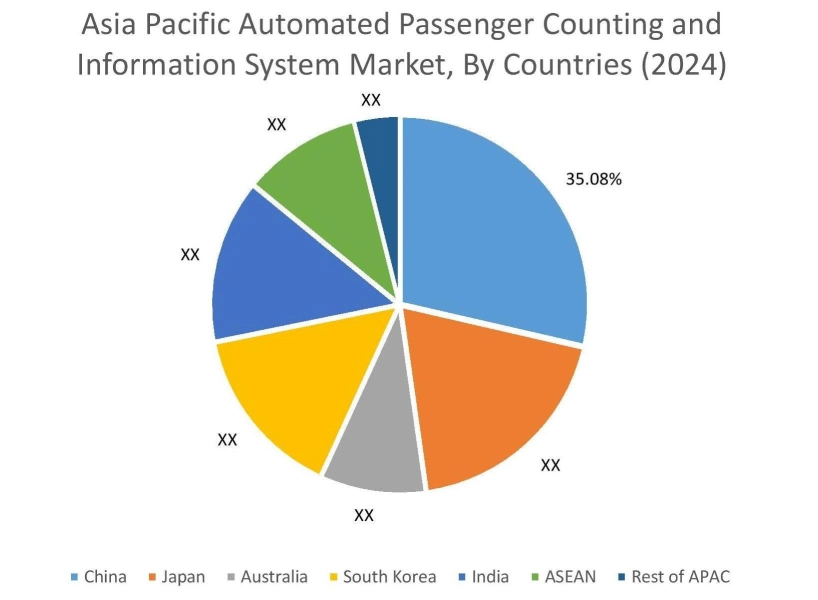
North America is estimated to reach over USD 6.99 Billion by 2032 from a value of USD 3.15 Billion in 2024 and is projected to grow by USD 3.42 Billion in 2025. The North American market is primarily driven by robust government support and funding for public transport modernization, coupled with the increasing need for real-time transit data to enhance operational efficiency and the passenger experience.
- For instance, Cubic Corporation offers Umo IQ which is a SaaS transit management platform designed to enhance both rider experience and operational efficiency. It provides real-time passenger information (RTPI) including accurate arrival/departure predictions, trip planning, and automated onboard announcements.
The regional analysis depicts that accelerating the shift towards sustainable, smart, and digital mobility in Europe is driving the market. Additionally, the factor driving the market in the Middle East and African region is the significant government investments in smart city initiatives. Further, based on analysis, increasing urbanization and growing demand for improved public transport efficiency across the region is paving the way for the progress of market trends in Latin America region.
Top Key Players and Market Share Insights:
The global automated passenger counting and information system market is highly competitive with major players providing solutions to the national and international markets. Key players are adopting several strategies in research and development (R&D), product innovation, and end-user launches to hold a strong position in the automated passenger counting and information system industry. Key players in the global automated passenger counting and information system market include-
- Init SE (Germany)
- Siemens AG (Germany)
- Clever Devices Ltd (US)
- HELLA Aglaia (Germany)
- Trapeze Group (Canada)
- Hitachi, Ltd. Japan
- DILAX Intelcom GmbH (Germany)
- Cubic Corporation (US)
- iris-GmbH infrared & intelligent sensors (Germany)
- Eurotech S.p.A. (Italy)
Recent Industry Developments :
Partnerships
- In February 2025, INIT is driving the modernization of Luxembourg's nationwide bus telematics system, GloTel. The five-year contract with the Administration of Public Transport (ATP) involves upgrading the existing Intermodal Transport Control System to the next generation MOBILE-ITCS nextGen.
Automated Passenger Counting and Information System Market Report Insights :
| Report Attributes | Report Details |
| Study Timeline | 2019-2032 |
| Market Size in 2032 | USD 20.16 Billion |
| CAGR (2025-2032) | 9.4% |
| By Offering |
|
| By Technology |
|
| By End User |
|
| By Region |
|
| Key Players |
|
| North America | U.S. Canada Mexico |
| Europe | U.K. Germany France Spain Italy Russia Benelux Rest of Europe |
| APAC | China South Korea Japan India Australia ASEAN Rest of Asia-Pacific |
| Middle East and Africa | GCC Turkey South Africa Rest of MEA |
| LATAM | Brazil Argentina Chile Rest of LATAM |
| Report Coverage |
|
Key Questions Answered in the Report
How big is the automated passenger counting and information system market? +
The automated passenger counting and information system market is estimated to reach over USD 20.16 Billion by 2032 from a value of USD 9.07 Billion in 2024 and is projected to grow by USD 9.84 Billion in 2025, growing at a CAGR of 9.4% from 2025 to 2032.
What specific segmentation details are covered in the automated passenger counting and information system report? +
The automated passenger counting and information system report includes specific segmentation details for offering, technology, end user, and regions.
Which is the fastest segment anticipated to impact the market growth? +
In the automated passenger counting and information system market, railways is the fastest-growing segment during the forecast period.
Who are the major players in the automated passenger counting and information system market? +
The key participants in the automated passenger counting and information system market are Init SE (Germany), Siemens AG (Germany), Hitachi, Ltd. (Japan), DILAX Intelcom GmbH (Germany), Cubic Corporation (US), iris-GmbH infrared & intelligent sensors (Germany), Eurotech S.p.A. (Italy), Clever Devices Ltd (US), HELLA Aglaia (Germany), Trapeze Group (Canada) and others.
What are the key trends in the automated passenger counting and information system market? +
The automated passenger counting and information system market is being shaped by several key trends including increasing integration of AI and IoT for enhanced real-time data analytics, growing demand for personalized passenger information, and the continuous focus on optimizing operational efficiency and safety.
